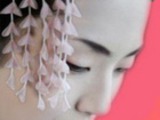in group Materials from partners
Japanese secrets of youth and symmetry

▪ Small portions of various products for each meal. Even the ordinariest Japanese meal (a lunch or a dinner) can include from 5 to 30 dishes, besides, in the most fancy combinations. Cooking in Japan is similar to writing of a picture or the composition of a hokku (the Japanese poetry) – everything matters, deep meaning. The dishes are served on small beautiful plates, everyone separately. Portions are small, they are absorbed slowly, and this process is controlled by reason. Japanese do not adhere to separate food.
▪ Weak heat treatment guarantees high safety of vitamins B dishes. Products can be only slightly boiled thoroughly, slightly fried, slightly extinguished. Many dishes are prepared in double boilers, microwave ovens. For example, soy soup is cooked in only two minutes, otherwise it is possible to destroy a vitamin complex of the soy paste which is a part of soup. Many products in Japanese cuisine are used in the raw. Fish fry in a grill, eat crude (the well-known sushi).
▪ Rees instead of bread. Consumption of bread in Japan is much lower, than in the West - here it is replaced by shelushyony rice. It is a basis of the Japanese menu.
▪ Main products: fish, rice, soy, vegetables, green tea, fruit, citrus. Emphasis on fish and seafood. Eggs – no more than 1 piece a day, milk – about a half of a glass. Any bacons, sausages, hamburgers, but there are a lot of fresh vegetables: garden radish, daikon, salad, edible seaweed, soy tofu cheese. During the poll of Japanese it became clear that their weekly diet includes more than one hundred various dishes.
▪ the Green tea rich with antioxidants and C and E vitamins giving youth and cheerfulness. In the 9th century Japanese borrowed a habit to have green tea from Chinese - and since then the tradition of a tea ceremony was so strongly interwoven (tyana) into the culture of Japan and life of each Japanese that even the rough rhythm of modern life cannot prevent this religious rite. Japanese see sense of a tea ceremony in saying: "The Tyana is a worship of beauty in gray light of everyday life".
▪ Tiny desserts (is more often from fruit), pastries – from rice flour. Japanese love puddings, but eat them in the small portions. Almost never Japanese add butter and dairy products to the desserts, and sugar consume three times less, than female residents of the western countries. One more favourite Japanese delicacy are various jellies made from different grades of gelatin of "agar-agar". From gelatin the Japanese ekan fruit jelly, various festive desserts with addition of fresh fruit and even drinks prepares.
▪ Rituality, harmony and beauty of laying. Preparation of the Japanese food, appearance of dishes, laying and a meal it is full of grace. The Japanese religion of Shintoism considers the nature sacred. It explains respect of Japanese for structure and appearance of food. Japanese cuisine is a peculiar familiarizing with the nature.
▪ Use of chopsticks. To Japan a stick (hasa) came from China in the 12th century and were made of a bamboo. Modern scientists in Japan consider that sticks train the small muscles developing mental capacities therefore in Japan learn to address from a hasa since small years. Sticks are how useful to development of mind, we do not know, but precisely to swallow a lunch in two minutes with their help it will not turn out.
 Of course, you should not explain great appearance of Japanese only with traditions of healthy food - a lot of things depend also on care of skin, hair, a body. Is and here Japanese have secrets.
Of course, you should not explain great appearance of Japanese only with traditions of healthy food - a lot of things depend also on care of skin, hair, a body. Is and here Japanese have secrets.• Hair shine. Japanese know centuries about effect of oil from camellias. The camellia contains proteins and oleic acid. Both substances well get into structure of hair, give volume and smooth hair so the getting light is reflected better. Preparation: 1 teaspoon of oil of a camellia slightly to heat, rub on length and tips of moist hair. To cover with a towel, in 20 minutes to apply shampoo on hair, to make foam it fingers and it is good to wash out.
• Face pack. Add to white clay the oats crushed in powder, rice bran, small chopped seaweed, camomile flowers. Here to add jojoba oil on 1 tsp, a dogrose, a camomile and there is a little water (before giving to the mass of density of paste), accurately rub a mask in face skin and leave for ten-fifteen minutes. To wash away cool mineral water (without gas).
• Apple cider vinegar. Japanese add it to shampoos for prevention of dandruff, degreasing of roots of hair, stimulation of their growth, add to a bathtub to keep skin young and healthy, in means for removal of a make-up, add several drops to oils of a camellia, camomile, a lavender, rosemary, mix with root extract alteya pharmaceutical, nettles - and wipe with these lotions a face.
• Sea salt. Sea salt is mixed with juice scarlet, dirt, seaweed and rub with these structures a body at water procedures. Perfectly helps at cellulitis.
• Massage. Massage is considered the most effective procedure for restoration of beauty and health. Unlike the European techniques, the Japanese technicians are aimed not at relaxation of soul and a body, and at association of all hidden reserves of an organism in fight against this or that illness, including, and over time. Shiatsu - Japanese so call daily massage for the person which they use to keep the porcelain skin. It is carried out by easy contacts of finger-tips very slowly and, the most important, is regular: every day five minutes, in the morning or in the evening.
The Japanese women love cosmetics too, and this cosmetics has features. The Japanese attitude towards beauty and means for its maintenance differs from the European radically. Here personal care — it a ritual is similar to a tea ceremony. For the Japanese cosmetics is an opportunity to decorate not so much itself how many the life, to recover daily occurrence, to enjoy each its moment. From here gravity to all details of "a cosmetic ceremony". Each detail, a trifle has to be in harmony with whole: packing registration, aroma and color of the means, pleasure from its drawing, additional accessories (ware for preparation of masks, sponges, brushes, brushes...). The Japanese cosmetics mostly natural is a minimum of preservatives and only vegetable components. Pearls, more precisely a pearl protein konkhiolin – antioxidant, anti-allergen, a humidifier and the defender from ultraviolet rays often are its part. One more important component - a silk protein fibrion, holding seven times more than moisture, than other moistening components.
The combination of ancient secrets and modern technologies, traditions of healthy kitchen, the harmonious relation to life allow Japanese to live long and to be harmonious, beautiful and young for many years!
Copy the code and insert into a window of creation of record on LiveInternet, previously having included the Source mode there.
HTML-code: 
|
|
| The BB code for forums: |
How will it look?
wowcharm.us → Japanese secrets of youth and symmetry

|
Japanese selected following "golden rules" of the traditional style of food: ▪ Small portions of various products for each meal. Even the ordinariest Japanese meal (a lunch or a dinner) can include from 5 to 30 dishes, besides, in the most fancy combinations... Read more: |
| "Expert | | | Secrets of beauty of models" |
|
Other discussed materials:
Pokhvalyushka. A prize for the competition "My New Year's Adventures"
The anniversary couture ARMANI PRIVE collection spring-summer 2025 from Giorgio Armani.
Welcome to Theatre of Aroma. Smart DIAMANTE and all its sides are poured by hot spices.
I begin to test means for purity in the house
|










